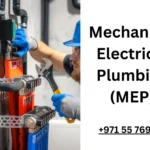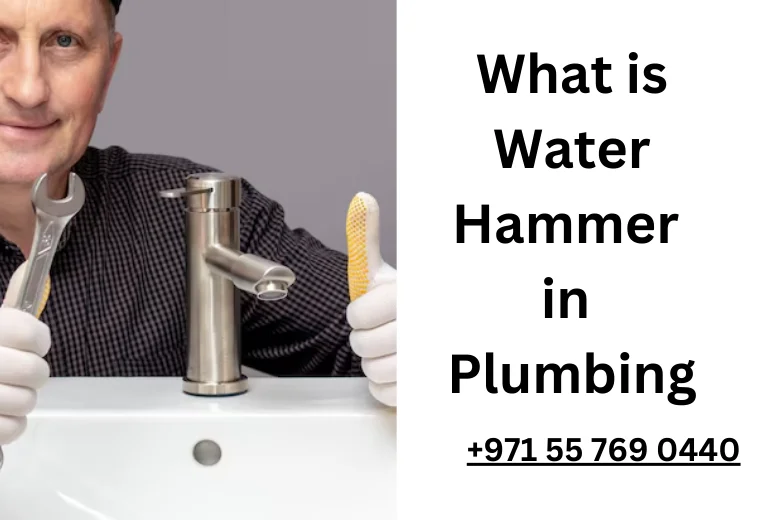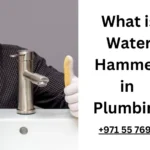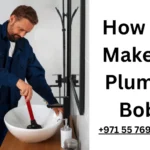
Introduction
If you’ve ever heard loud banging or clunking noises. When turning off a faucet or when your washing machine finishes filling up. You’ve likely experienced what’s called water hammer. This issue is more than a mere annoyance; it’s a sign of potential problems within your plumbing system. Water hammer occurs when water flow is suddenly stopped, causing a pressure surge that reverberates through the pipes. Left unresolved, this can cause significant damage to your plumbing, including pipe bursts and appliance malfunction. In this guide, we will explore what water hammer is, its causes, dangers, and, most importantly. The noise reduction solutions you can apply to prevent this issue.
What is Water Hammer?
Water hammer, also known as hydraulic shock, is a phenomenon that occurs when a high-speed stream of water is suddenly halted. Leading to a shockwave reverberating through the pipes. The sudden stoppage of water flow can occur when appliances. Like dishwashers, washing machines, or faucets are turned off quickly, causing the water in the pipes to slam into closed valves. This impact sends a shockwave back through the system, resulting in the characteristic banging sound.
In a properly functioning plumbing system, air chambers or water hammer arresters absorb the pressure created by this abrupt water stoppage. However, when these systems fail or are not present, the water pressure has. Nowhere to go, causing the pipes to shake and make noise. Not only is this an inconvenience, but over time, water hammer can damage pipe connections, valves, and even appliances.
Causes of Water Hammer
High Water Pressure
One of the most common causes of water hammer is excessive water pressure in the plumbing system. When the water pressure is too high, even a minor stoppage in the water flow can create a shockwave powerful enough to cause banging noises. Residential plumbing systems should typically have water pressure between 40 and 60 psi (pounds per square inch). Anything above this range increases the likelihood of water hammer. High water pressure doesn’t just lead to noise—it can also strain your pipes and appliances, leading to leaks and bursts over time.
Fast-Acting Valves
Many modern appliances, such as dishwashers, washing machines, and ice makers, have fast-acting valves known as solenoid valves. These valves can shut off the water supply very quickly, sometimes in less than a second. When the water flow is suddenly stopped by these valves, it creates a high-pressure wave that reverberates through the plumbing system, causing water hammer.
Loose Pipes or Fittings
Another common cause of water hammer is loose pipes. When pipes aren’t securely fastened to wall studs or joists, they can move around when water is suddenly stopped. The movement of the pipes amplifies the noise caused by water hammer and can lead to even more severe issues if left unaddressed, such as pipe wear and leakage. Loose pipe fittings can also exacerbate the problem, as water hammer can cause joints to weaken over time, leading to small leaks that may go undetected for months.
Clogged or Non-functional Air Chambers
In traditional plumbing systems, air chambers are installed to absorb the shock caused by water hammer. These chambers are essentially vertical sections of pipe located near water fixtures. They are designed to trap air, which cushions the shockwave caused by the sudden stoppage of water. Over time, these air chambers can become filled with water or debris, rendering them ineffective. When the air chamber fails, there’s nothing to absorb the shock, resulting in a water hammer.
Dangers and Long-term Effects of Water Hammer
Water hammer isn’t just a noisy inconvenience; it poses several risks to your home’s plumbing and can lead to more severe and costly problems if not addressed.
Pipe Ruptures and Bursts
One of the most significant dangers of untreated water hammer is the potential for pipe ruptures. When water pressure is repeatedly slamming against the pipe walls, it weakens the joints and connections over time. This can eventually lead to pipe bursts, which can cause extensive water damage to your home and necessitate expensive repairs.
Damage to Valves and Appliances
The constant pressure surges caused by water hammer can also damage plumbing valves and appliances. Washing machines, dishwashers, and refrigerators with ice makers are especially vulnerable to this type of damage. Over time, the repeated strain on solenoid valves or other water connections can cause premature wear and tear, leading to appliance malfunction.
Leaks and Structural Damage
Even minor leaks caused by water hammer can result in significant long-term damage. Water leaks can lead to mold growth, wood rot, and even compromise the structural integrity of your home if left unchecked. The persistent leaks caused by water hammer often occur in hard-to-reach areas, such as inside walls or beneath floors, making them difficult to detect until extensive damage has already been done.
Noise Reduction Solutions for Water Hammer
Install Water Hammer Arresters
Water hammer arresters are devices designed specifically to absorb the pressure waves created by the sudden stoppage of water flow. They function similarly to air chambers but are more reliable over time because they do not rely on trapped air that can dissipate. Water hammer arresters contain a piston or diaphragm that separates the water from the air or gas inside the arrester, providing a cushion for the shockwave. These devices are relatively easy to install and can be placed near appliances or fixtures that frequently cause water hammer, such as dishwashers or washing machines.
Secure Loose Pipes
One of the easiest and most cost-effective ways to reduce water hammer is to ensure that all pipes are securely fastened. Pipes should be secured to wall studs or joists using pipe clamps, clips, or hangers. If your home has copper pipes, avoid using steel or galvanized clamps, as the combination of different metals can cause corrosion. Instead, use plastic or rubber-lined clamps, which will hold the pipes securely without causing metal degradation.
Install or Reset Air Chambers
If your plumbing system includes air chambers, but you’re still experiencing water hammer, the chambers may need to be drained. Over time, these chambers can become waterlogged and lose their effectiveness. To reset the air chambers, you will need to shut off the main water supply and open all the faucets in your home, starting from the highest faucet and working your way down. This will allow the water in the pipes to drain and the air chambers to refill with air, restoring their ability to absorb shock.
Adjust Water Pressure
If high water pressure is the cause of your water hammer, installing a pressure regulator can help mitigate the issue. A pressure regulator ensures that the water entering your home is at a safe and consistent pressure level, usually between 40 and 60 psi. Installing a pressure gauge can help you monitor your water pressure and ensure it remains within the recommended range. If your water pressure is consistently high, it can not only cause water hammer but also damage appliances like dishwashers and washing machines over time.
DIY Steps to Fix Water Hammer
Step 1: Shut off the Water and Drain the System
To begin any water hammer repair, shut off the main water supply to your home. Once the water is off, open the faucets starting from the highest point in your home and work your way down to the lowest faucet. This will allow the water in the system to drain out, resetting the air chambers or giving you access to pipes that need to be worked on.
Step 2: Install Water Hammer Arresters
Once the system is drained, install water hammer arresters near appliances or fixtures that are causing the issue. For washing machines or dishwashers, arresters are typically installed on the water intake line. These devices can be screwed in without the need for cutting or soldering pipes, making them a relatively simple DIY fix.
Step 3: Secure Loose Pipes
After installing water hammer arresters, inspect the pipes throughout your home for any loose sections. Secure these loose pipes using pipe straps or clamps, paying special attention to areas where the pipes may be vibrating or moving during water flow.
Step 4: Test the Water Pressure
Finally, test the water pressure using a gauge attached to an outdoor hose bib or faucet near the main water supply. If the water pressure is higher than 60 psi, consider installing a pressure regulator to bring it down to a safe level.
When to Call a Professional
While many water hammer issues can be addressed through DIY solutions, some situations may require the expertise of a professional plumber. If you’ve tried the above methods and are still experiencing water hammer, or if you notice persistent leaks, burst pipes, or appliance malfunctions, it’s time to call in a professional. A plumber can assess the situation, identify any underlying issues, and provide more advanced solutions, such as installing a pressure-reducing valve or replacing worn-out pipes.
Preventative Measures
Regular Plumbing Maintenance
Prevention is the best way to avoid the problems caused by water hammer. Regularly check your plumbing for signs of loose pipes, worn-out valves, or leaking joints. Performing routine maintenance on your home’s water pressure system can also help prevent water hammer before it starts.
Proper Installation of Appliances
When installing new appliances that are connected to your home’s water supply, such as dishwashers or washing machines, ensure they are installed correctly to prevent fast-acting valves from creating water hammer. If you’re unsure, it’s always a good idea to hire a professional plumber for the installation.
Securing Pipes During Renovations
If you’re planning any home renovations that involve opening up walls or floors, take the opportunity to inspect and secure any pipes that may be exposed. Properly securing the pipes during construction can prevent water hammer from becoming an issue in the future.
Conclusion
Water hammer is a common yet potentially damaging plumbing issue that can lead to costly repairs if not addressed. By understanding the causes of water hammer and implementing the appropriate noise reduction solutions such as installing water hammer arresters, securing loose pipes, andimplementing pressure regulators homeowners can significantly reduce or eliminate the occurrence of water hammer. Regular maintenance and preventative measures are also crucial to avoid the long-term effects of this issue, which can include damaged pipes, malfunctioning appliances, and even structural damage to your home.
If you’ve tried the DIY fixes mentioned above and are still hearing those annoying bangs, or if you’re facing persistent issues like leaks, it’s best to call a professional plumber to diagnose and repair your plumbing system. Tackling water hammer early can save you from expensive repairs and give you peace of mind knowing your plumbing system is in good working order.



